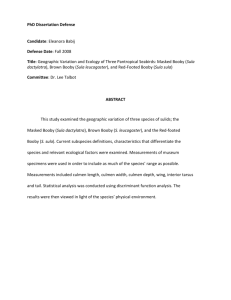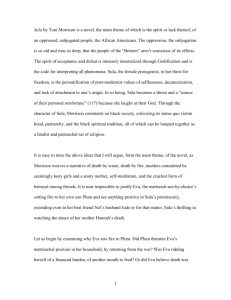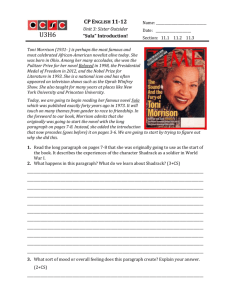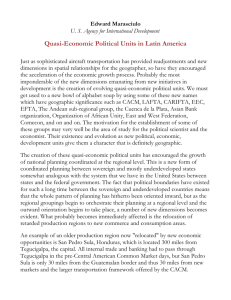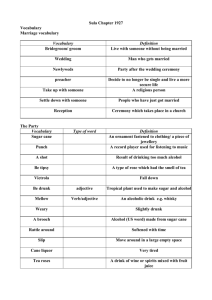In Search of Self: Frustration and Denial in Toni Morrison's Sula
advertisement
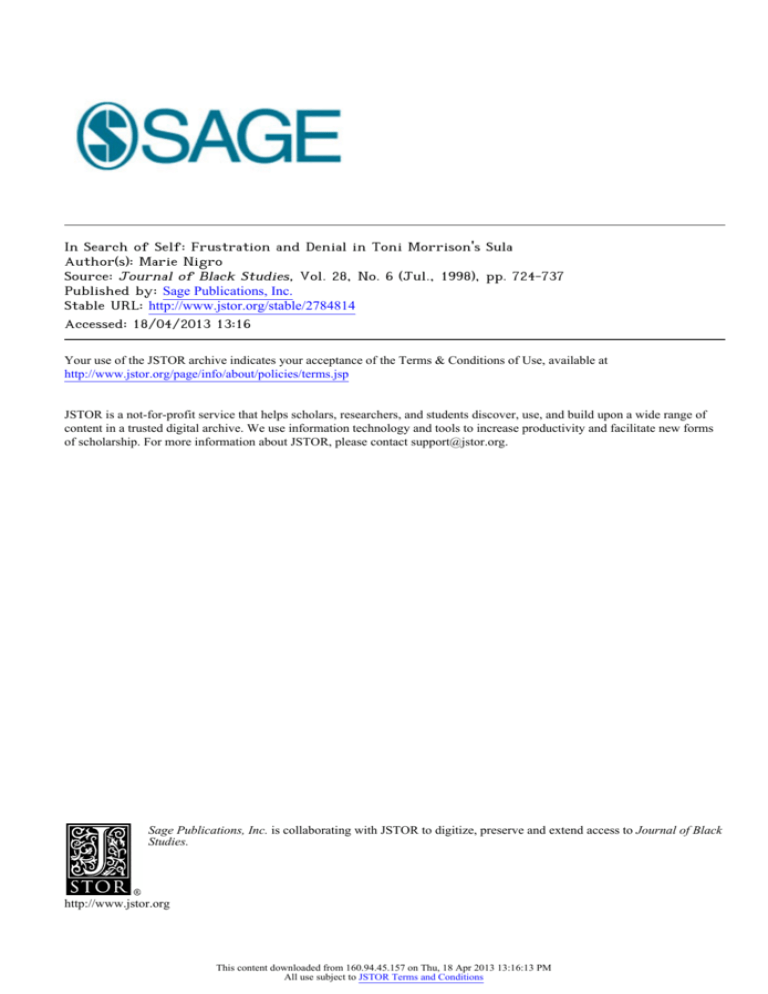
In Search of Self: Frustration and Denial in Toni Morrison's Sula Author(s): Marie Nigro Source: Journal of Black Studies, Vol. 28, No. 6 (Jul., 1998), pp. 724-737 Published by: Sage Publications, Inc. Stable URL: http://www.jstor.org/stable/2784814 . Accessed: 18/04/2013 13:16 Your use of the JSTOR archive indicates your acceptance of the Terms & Conditions of Use, available at . http://www.jstor.org/page/info/about/policies/terms.jsp . JSTOR is a not-for-profit service that helps scholars, researchers, and students discover, use, and build upon a wide range of content in a trusted digital archive. We use information technology and tools to increase productivity and facilitate new forms of scholarship. For more information about JSTOR, please contact support@jstor.org. . Sage Publications, Inc. is collaborating with JSTOR to digitize, preserve and extend access to Journal of Black Studies. http://www.jstor.org This content downloaded from 160.94.45.157 on Thu, 18 Apr 2013 13:16:13 PM All use subject to JSTOR Terms and Conditions IN SEARCH OF SELF Frustrationand Denial in ToniMorrison'sSula MARIENIGRO LincolnUniversity AlthoughToni Morrison (1973) may not have intentionally createda novelto celebratetheworkingclass or to explorethe consequencesofworkamongAfrican Americans, shehas,inSula, celebratedthelivesof ordinary peoplewhodailymustworkand provide.Sula celebrates manylives:Itis thestoryofthefriendship oftwoAfrican American women;itis thestory ofgrowing upBlack andfemale;butmostofall,itis thestoryofa community. Events thatbefallthedenizensoftheBottom,a segregated of community mythical Medallion,Ohio,can be seenas thosethatmightbefall residents ofanyBlackcommunity in anytownduringtheyearsof thisnarrative, 1919to 1965. Historically, greatliterature has concerneditselfwithnature, have been literary death,and love. Writers professionals whose primary occupationwas writing and whoseexperiences werefar removedfromthosewhomustworkfora living.Criticssuchas NicholasColes (1986), TerryEagleton(1986), Louis Kampfand Paul Lauter(1972), andJohnWayman(1983) haveobjectedto a historical canonthatis irrelevant to "everyman." Eagleton(1986) observesthatliterature has beencreatedfortheculturalelite,and therestofus havecometoconsiderliterature as a reflection ofan elitistlifestyle to whichtheordinary personcannothopetorelate. AUTHOR'S NOTE: I wishtoacknowledge theinvaluablehelpofmycolleague as wellas the Ropo Sekoniwiththeeditingofthefinalversionofthismanuscript assistanceofmyfriendSara Ramponwhohelpedwiththeearlyorganization. JOURNALOF BLACK STUDIES, Vol.28 No. 6, July1998 724-737 Inc. C 1998Sage Publications, 724 This content downloaded from 160.94.45.157 on Thu, 18 Apr 2013 13:16:13 PM All use subject to JSTOR Terms and Conditions Nigro/IN SEARCH OF SELF 725 He suggeststhattheliterary establishment embraceworksthat celebratethelivesofordinary peopleandacknowledge thestrugglesofrealpeople,forexample,working-class writing. as thatwritten Coles (1986) definesworking-class literature by writers fromworking-class working-class personsorprofessional He stressestheimportance of creatingand reading backgrounds. textsformostpeople,including minorities, women,andworkingclass students. KampfandLauter(1972) alsoseeliterature andliterary criticism fromlife-as a self-serving as separated ideologythatis relatedto butoffers establishment thelivesoftheliterary toreaders nothing familiesorworking-class whomaybe fromordinary backgrounds. ofcontemporary Wayman(1983) decriestheirrelevancy imaginawhichhas nothingto offerworking-class menand tivewriting, does notdeal women.He findsit wrongthata nationalliterature andsuccessesofthemajority with"problems, aspirations, failures, thecountry" ofmenandwomenwhoinhabit (p. 43). He notesthat ourculture,by ignoring realpeopleand realproblems, is saying that"weandourproblems arenotsignificant" (p. 55). He seeswork inourlives"(p. 55), an experience as a "majorshapingexperience in thatdeservestobe celebrated literature. If,as Waymansuggests, workis themajorshapingfactorin ourlives,whataretheconsea demeaning quencesof havingno work,of enduring job, or of havingno outletforone'screativeenergies? In an interview withClaudiaTate(1983), ToniMorrisonnotes that It wouldbe interesting to do a pieceofworkon thekindsofwork womendo innovelswritten bywomen.Whatkindsofjobs theydo, notjust thepayingjobs, buthow theyperceivework.... It's not kinds justa questionofbeinginthelaborforceanddoingdomenstic ofthings;it'sabouthowoneperceiveswork,howitfitsintoone's life.(p. 123) is notas newtoBlackwomenas itis towhite She adds,"Agression women.Black womenseem able to combinethe nestand the adventure.... We don'tfindtheseplaces,theseroles,mutually exclusive"(p. 122). This content downloaded from 160.94.45.157 on Thu, 18 Apr 2013 13:16:13 PM All use subject to JSTOR Terms and Conditions 726 JOURNALOF BLACK STUDIES /JULY 1998 oftheBottom,survivalis serious knitcommunity In thetightly a meansofexistingina business,andeachpersonmustdetermine manageas bestthey worldthatis alien-Whiteandmale.Residents and helpingeach otherbut can,workingmenialjobs, scrimping, by prescribed boundaries withintheunderstood alwaysremaining thehostileWhiteworld. AlthoughMorrison'snovelis "imbeddedin thecontextof the Black experiencein America"(Holloway& Demetrakopoulos, tothereader 1987,p. 149),theauthorofSula succeedsinbringing and thepainof Eva, Hannah, of anyrace thejoys,thesuffering, Sula, Jude,andShadrack. delineatesSula's familytree,allowMorrison(1973) carefully youngwoman theremarkable ingthereaderto betterunderstand thatis Sula Peace. Beforewe evermeetMiss Peace, we meether toBoy-Boy,finds Eva, whoafter5 yearsofmarriage grandmother, herselfabandonedwiththreechildrenand no idea of whatto do next.Neighborsbringwhatfoodtheycan spare,butEva realizes to thatshewillsoonwearoutherwelcome,so sheasksa neighbor tobe backina fewdays.Eighteen andpromises watchherchildren witha shinynewpurseand on crutches monthslater,shereturns andEva startsbuilding monthly, one leg. A checkbeginsarriving Road. a houseon Carpenter Hannah,is widowedwhenheronlychildSula Eva's daughter, movein withEva whereHannah is age 3. Motherand daughter andhermother. forherdaughter a life of caring settlesintoassume household.With Eva andHannahcreatetheirownunconventional mother anddaughter love ofEva's husbandBoy-Boy, theexception playing all men.Eva expressesherloveformalenessbylaughing, her mencallers,anddisplaying talkingwithherfaithful checkers, and shodat all times" one leg, whichis "stockinged remaining 1973,p. 31). (Morrison, For Hannah,love ofmenandmalenessis physicalbutwithout guile.She enjoysthecompanyof menand leads themenof the Bottomto herbed. Her lovingis describedas "sweet,low and guileless... nobody,butnobodycouldsay 'Hey sugar'likeHannah"(Morrison, 1973,pp.42-43). This content downloaded from 160.94.45.157 on Thu, 18 Apr 2013 13:16:13 PM All use subject to JSTOR Terms and Conditions Nigro/IN SEARCH OF SELF 727 The businessof survivalis an everydayconcernforEva and Hannah,butbecausetheyareBlackwomeninthe1920s,theonly paid workavailablein Medallionis as domesticsforungrateful Whitefamiliesor as prostitutes. And even theprostitutes have fallenon hardtimes.So motherand daughter devisetheirown meansofcoping.Duringthesummer, theyjoin theirneighbors in canningtheharvestoffruits andvegetablesin preparation forthe hardwinterahead. The mysterious loss of Eva's leg providesa much-awaited monthly check.In addition, Eva takesinan arrayof boardersandstraypeople,someofwhompayandsomeofwhom do not.It is in thisunconventional and oftenchaotichousehold, filledwithboarders, andgentlemen adoptedchildren, callers,that Sula Mae Peace growsup. In anotherpartof theBottom,in a houseof suffocating order andreallace curtains, Nel Wright is growing up underthecareful eye of HeleneWright. Sula and Nel meetin schooland become friends whofindineachotherwhateachlacksinherself. Coming froman oppressively Nel relishesthecasual disneathousehold, orderofSula's household, wherepeopledropinunannounced, chat, and laughand wheredirtydishesor stackednewspapers pile up. On theotherhand,Sula enjoysgoingtoNel's housewhereshecan siton theredvelvetsofain thequietofan afternoon for10 to 20 minutes-"stillas dawn"(Morrison, 1973,p. 29). The girlsgrow intowomanhoodclingingto each other,each providing whatthe otherlacksinherself. Morrison explainstothereaderthatthetwo "felttheease andcomfort girlsmetandimmediately ofoldfriends. Becauseeachhaddiscovered thattheywereneither whitenormale, andthatall freedom andtriumph was forbidden tothem,theyhave set aboutcreatingsomething else to be" (p. 52). Togetherthey createa singlecompleteindividual: Sula theimpulsive, emotional the one; Nel practicalone. Aftergraduating fromgeneralschool,Sula goestocollege,and Nel marriesJudeGreene.Underhermother'swatchful eye,Nel andJudehavea "real"weddingina church followedbya reception has spentdayspreparing. thatHeleneWright Judeis a handsome in thechurch.He is 20 yearsold youngmanwhosingsregularly This content downloaded from 160.94.45.157 on Thu, 18 Apr 2013 13:16:13 PM All use subject to JSTOR Terms and Conditions 728 JOURNALOF BLACK STUDIES /JULY 1998 andworksas a waiterintheHotelMedallion.Judeknowshisjob could neversupporta wife,but he has plans to move on to He hashiseyeon theNew RiverRoad. morelucrative. something Medallionhas neededa bridgethatwouldspantheriverand acrossto thenext usedto takeresidents replacetheraftpresently ofa theplansarelaterchangedtotheconstruction town.Although tunnel,theprojectis stillcalled theNew RiverRoad. Workhas begunwhenJude,alongwitha fewotheryoungBlack men,go wantsto be partof down to thehiringshack.Judedesperately he couldpointto thatwouldlast,something buildingsomething traysand other withpride.He longedforrealwork,notcarrying he wantedthecamarapeople'sdirtydishes."Morethananything derie of road men . . . thatin the end produced somethingreal, thathe couldpointto.... 'I builtthatroad,'he could something 1973,pp. 81-82). say"(Morrison, Judestandsin linefor6 daysandsees thegangbossespickout Whiteboys,Greeks,andItaliansbutnevertheyoungmen southern hisjob at thehotel is offended; fromtheBottom.His masculinity tocarrytraysandpickup butitis demeaning notonlypayspoorly, theself-affirming afterotherpeoplewhenhe wantsso desperately had existed before.Itwas where nothing job ofbuildingsomething thatshewill toNel. He determines thenthathe considersmarriage hisfortune. She whatever She wouldalwaysbe there, be hisanchor. wouldbe someonetowhomhecouldalwayscomehome;hecould Judeand careforher.WithNel,he couldbe complete.Together, Jude toonce Nel couldmakea completeperson.So Neljoinswith again mergeherselfwithanother.She recognizesher role and herhusband, raises She supports theexpectedfunctions: performs andjoinsthechurch. theirchildren, Duringan era in whichtheroleoftheBlack womanis clearly tobe herself. Sula,unlikeNel,is determined defined, andstiflingly ofherraceand boundaries She refusesto accepttheconventional themoresoftheoutsideworldas wellas andbyrejecting gender, Sula standsalone.Whenshereturns her own community, thoseof toMedallionafter10 years,lookingfineandwearingcityclothes, When thanherMedallioncounterparts. sheappearsmuchyounger This content downloaded from 160.94.45.157 on Thu, 18 Apr 2013 13:16:13 PM All use subject to JSTOR Terms and Conditions NigroI IN SEARCH OF SELF 729 Eva scowlsather,suggesting that hergrandmother, sheconfronts andhavesomebabies. sheneedstogetmarried Sula replies,"I don'twantto makesomebodyelse. I wantto thata woman makemyself'(Morrison,1973,p. 92). Eva retorts a man.Shortly (p. 92) aroundwithout has no business"floating" a homeforthe SulaplacesEva inSunnydale, after thatconversation, act. notesthisas Sula's first aberrant Thecommunity quietly elderly. to to theBottomwithabsolutelynothing do; the Sula returns move.All thetownknows townwatcheshereveryunconventional thatshe has beento collegeand livedin thebig cities.It is even andsleptwithWhite thatshehaddonetheunforgivable whispered men.Morrison(1973) explainsSula's dilemma: toengagehertremenHad shepaints,orclay... hadsheanything whichmighthave exdous curiosityand hergiftformetaphor, withwhimforan activandpreoccupation changedtherestlessness itythatprovidedherwithall she yearnedfor.And likeanyartist shebecamedangerous. (p. 121) withno artform, Dangerousindeed.Yet she neverrealizeshow dangerousshe Duringanafternoon reallyis becausehersinsareneverintentional. diapers,sheasksSula aboutlifeinthe visit,whileNel is sprinkling bigcity.Sula repliesthattherestoftheworldisjusta biggerversion ofMedallion.Later,whenNel walksin on Sula andJude,theyare naked.Jude,stillwaitingtablesatthehotel,and downon all fours, else todo,eachneedingtofillup spaceintheir Sula,withnothing and in thatone lives,have foundeach otherforthatmoment, ordered domesticlifeceasestoexist.Jude moment, Nel's carefully andNel is leftwithonly packsup andleaveson a busforDetroit, hisyellownecktieanda grayfuzzyballthatfollowsherwherever shegoes. Nel wonders, moment ofdiscovery, How Relivingthatdreadful leave? The two most couldSula havedonethat?How couldJude her.Nothingis leftbut important peoplein herlifehavebetrayed aboutherheadandthepressing need thatgrayfuzzyballhovering to carryon forherselfand her children.She takesa job as a attheHotelMedallion.AndSula, surprised atNel's chambermaid This content downloaded from 160.94.45.157 on Thu, 18 Apr 2013 13:16:13 PM All use subject to JSTOR Terms and Conditions 730 JOURNALOF BLACK STUDIES /JULY 1998 discoversthatNel is one of"them."Now Nel belongsto reaction, and actsas she herthatNel is so offended thetown.It surprises is one ofthereasonsSula has returned toMedaldoes.Herfriend has orreform lion,andnowNel is lost.Sula's refusaltoconform sheevercraved.Sula cannotundercosthertheonlyrelationship standthatshehascausedNel intensepain,andthatbya singleact, is notcontrite as she Sula, however, Nel's lifeis changedforever. ofthecommunity. standsalone,outsidetheboundaries in herlife,Sula uses menmuchas her To fillup theemptiness spirit. mother(now deceased) had done but witha different WhereasHannahhad been sweetand withoutguileand had reSula goes tobed withmenas spectedthewaysofthecommunity, oftenas she can but thencarelesslytossesthemaside. Unlike Sula regardslovewas comforting, Hannah,forwhomlovemaking the The Bottom now hasevenmore as wicked. community of making intheir herpresence midst. reasontodespiseSula,yettheytolerate a devil?Here ShouldthereaderconsiderSula amoral,a monster, is a womanwho has ruinedthelifeof heronlyfriendand then Nel's pain.Hereis a womanwhobedsthemen cannotunderstand whoappearstohaveno purposeinher ofthetownwithbitterness, lifebutthatofself-gratification. of Sula, RenitaWeems(1983) observesthatin thecharacters Eva, andHannah, in tothosewomenwhoaredoingeverything Morrison paystribute lifebutwhattheyaresupposedtobe doing:creativewomen-like so manyof us andourmamas-withoutoutletsforourcreativity. withno artform"is howSula Peace is described. (p. 97) An "artist no outletforherenergiesandhercreativity, Andwithno artform, self-destructs. Sula, inherquestto "makeherself," intheBottom, Sula hasbecomea pariah. To thelittlecommunity haveeverknown, fromanyonethetownspeople Sula is different and becauseshe is notseekingmoneyor materialgain,shefeels toexplainheractions. shehasno obligation charBarbaraSmith(1983) observesthatSula is a frightening acterbecausesherefusesto settleforthe"coloredwoman's"lot. Smithrecallsherownexperience: This content downloaded from 160.94.45.157 on Thu, 18 Apr 2013 13:16:13 PM All use subject to JSTOR Terms and Conditions Nigro/IN SEARCH OF SELF 731 Havinggrownup in a familyof talentedwomenwho workedas in schoolsoftheSouthandas domestics inthesegregated teachers of theNorth,I saw firsthandthedemoralizing thewhitekitchens andcreativity. (p. 23) ofstymied intelligence effects Smithadds thatfolksin theBottomhateSula because she is a (p. 24). livesofresignation" oftheirdreadful "livingcriticism to her understand her she tries sickbed, WhenNel visitsSula on on livingherlifeas shechooses: insistence friend's You can'thaveitall,Sula. Why?I can do itall,whycan'tI haveitall? Youcan 'tdo itall.Youa womananda coloredwomanatthat.Youcan't actlikea man.You can'tbe walkingaroundall independent-like, youlike,takingwhatyouwant,leavingwhatyou doingwhatever 1973,p. 142) don't.(Morrison, as the Nel remindsSula of herisolationfromthecommunity is her loneliness that her Sula replies priceof herindependence. own, of her own making.Nel's, she pointsout is "somebody 1973,p. 143). lonely"(Morrison, else's.... A secondhand Sula Mae Peace diesbeforeher31styear.Whensherealizesthat pain,shesmiles," 'Well,I'll be damned,'she thedyingis without 1973, 'it didn'tevenhurt.Wait'llI tellNel' " (Morrison, thought, p. 149). Sula diesin 1941. 3, Shadrack, LifeintheBottomgoeson.Each year,on January wholivesoutsideoftown,marchesthrough a crazedarmyveteran NationalSuicideDay. hisownholiday, celebrating thecommunity Shadrackbeganthismorbidcustommanyyearsearlieras a means ofcopingwithhisownfearofdeath.A victimofWorldWarI shell thesmell totheBottom, buthecouldneverforget shock,hereturned himoutofhis of deaththathad beenall aroundhim,frightening onhisreturn, soughtnorreceivedcompanionship mind.He neither a mysterious bondwitha veryyoungSula. hehadformed although Whenthepeopleof theBottomrealizethathe is harnless,they andhiscelebration hisranting, drinking, leavehimalone,tolerating theholidayis that behind idea Shadrack's Day. ofNationalSuicide andifhecouldsetasideonedaya yearfordeath, deathis frightful, This content downloaded from 160.94.45.157 on Thu, 18 Apr 2013 13:16:13 PM All use subject to JSTOR Terms and Conditions 732 JOURNALOF BLACK STUDIES /JULY 1998 peoplecould "getit outoftheway"(Morrison,1973,p. 14) and nothavetothinkaboutitfortherestoftheyear.Andso,he began town hisowncelebration ofNationalSuicideDay,walkingthrough carrying a hangman's ropeandringing a bell.A fewotheroutcasts followhim,butusuallyShadrackmarchesaloneas peoplehustle andwatchfrombehindtheirwindows. offthestreet theirchildren The marchof 1942 (theyearfollowingthedeathof Sula) is foryearsto come. This year, and will be remembered different toNationalSuicideDay comesduringan espeShadrack'stribute in theirpoorly ciallycrueland bitterwinter;folksare shivering aresick;andadultsareweary.Shadrackis heatedhomes;children theloss ofhis onlyvisitor, Sula, andhas losthiszeal for grieving aboutcallingoffthemarch,butthebrilliant theholiday.He thinks ona winter's himtogo on.To hissurprise, sunlight dayencourages hefindsheis beingfollowedbylaughing children. No onehasever laughedduringhismarches.Soon adultsjoin themarch,laughing and the and dancing.Beckonedby the sunshine,the laughter, dancing,the crowdgrowslargerand largeras they"strutted, and shuffled downtheroad"(Morrison,1973, skipped,marched, theWhitepartoftownandheadfor p. 160).Theycontinue through site,thebricks, theNewRiverRoad.As theygaze attheexcavation and andtheirongirders, thetimber, theysee thebrokenpromises, thewords"noworktoday."As theygaze onthesite theyremember in thebrightwintersun,thedancingturnsto rage;thelaughter themarchers, whatishappening, menand ceases.Without realizing women,jumpoverthegateand pickup thesteelrails,smashing to thebricksandtimber, killingthetunneltheywerenotpermitted build. Whathappensnextis talkedaboutforyearstocome.The earth are lostin a wall ofwater. shifts, shoringsslip,and themarchers Manydie on thatNationalSuicideDay as Shadrackstandsthere hisbell. watching, ringing shifts fromthatawfuldayin 1942toa day narrative Morrison's thatthingsare betternow,or at A Nel observes mature in 1965. intheshopsin Coloredpeopleareworking least,theyseembetter. keys. town,someevenhandling moneyandwearingcashregister KarlaF. C. Holloway(Holloway& Demetrakopoulos, 1987) be- This content downloaded from 160.94.45.157 on Thu, 18 Apr 2013 13:16:13 PM All use subject to JSTOR Terms and Conditions Nigro/IN SEARCH OF SELF 733 lievesthatthenovelfinally belongstoNel,thesurvivor, whois still pickingup thepiecesofherlife,stillworking, and stilldoingthe "right thing"(p. 167).As partofhercharitable work,shevisitsthe aged Eva in Sunnydale. As Nel introduces herselftoEva, theold woman,barelyrational, rantsabouta longburiedchildhoodincidentinvolving Nel andSula. She mumblesa question,askingNel howshekilledthelittleboyso manyyearsago.Nel is quicktosay thatitwas Sula whothrewtheboyintotheriver. "You.Sula. What'sthedifference?" (Morrison, 1973,p. 168). Nel leaveshurriedly. Thisis notthevisitsheintended. Holding hercoat tightagainstthewinterwind,she beginsherlongwalk home.Suddenlyshestops.The softgrayballthathasbeenfollowingherforso longbeginsto breakand scatter. It is notuntilnow thatthegrayfuzzyball,whichhascoveredNel's heartsinceJude's departure, beginstobreakup. It is onlythenthatNel realizesthat itis notJudesheis missingbutSula. 'All thattimeI thought I was missingJude.... 0 Lord,Sula,' she cried'girl,girl,girlgirlgirlgirl.' It was a finecry-loud andlongbutit had no bottomand it had no top,just circlesand circlesof sorrow.(Morrison, 1973,p. 174) So perhaps, as Holloway(Holloway& Demetrakopoulos, 1987) has suggested,in the end thenovel is Nel's-Nel Wright, the Nel righteous theconforming one, one.She is,as Hollowaypoints out,"everywoman": "She carriestheadditional burdenofshadow thatwhiteculture projectsontoblackpeople.Butsheis stilltypical of mostwomenin Western culture"(p. 80). Hollowaycontinues how sympathetic thatno matter one maybe aboutJude'splight, "thebottomlineis thathe abandonshisfamily. It is Nel whoends up as sole parent;shecleanshousesto support thethreechildren whoformanyyearsbecameherlife"(p. 71). Because Sula is the storyof a community, the lives of its inhabitants areinextricably interwoven. AfterthedeathofSulathepariah,thedevil,theoutcast-thecommunity's roleofdefining itselfthrough acceptanceand disapprovalof one of itsmembers shifts.No longeris the she-devilthe focus of theircollective thatfollowsSula's death energies.The miseryoftheawfulwinter This content downloaded from 160.94.45.157 on Thu, 18 Apr 2013 13:16:13 PM All use subject to JSTOR Terms and Conditions 734 JOURNALOF BLACK STUDIES /JULY 1998 andstirsup theragethathas laindormant deepenstheirdiscontent and withouta focus.Shadrack'sparadecomes on sucha bright aredrawnin a spiritofbadly thatthetownspeople sunnymorning needed camaraderieand fun.Somehowthe dancing,laughing TheyearsoffrustraparadefindsitswaytotheNew Rivertunnel. wave ofrageas tion,ofpent-upanger,becomean uncontrollable to the Whiteworld's at monument hack and hurl the themarchers at thetunnelare refusalto letthemin. The violenceand tragedy a finalactofdefiance andironicbecausetheragerepresents fitting onNationalSuicideDay,a holiday committed forpromises unkept, to allayfearsof deathso thatpeoplecouldgeton with intended theirlives. that Earlyin thisarticle,I notedWayman's(1983) observation workshapesourlives,andI askedwhathappenswhena personhas no workor whena personis forcedto engagein workthatis I also notedMorrison'scomment orunsuitable. (Tate, demeaning is as to black women as it to white is not new 1983)that"Agression thedeadlyconsequences offers women"(p. 122).InSula,Morrison when the naturalfeelingsof aggressionlack a suitableoutlet Workneed ourworkthatwe defineourselves. becauseitis through to theconceptof earninga living:Workcan also notbe confined as thatoutletthatallows ourcreativeenergiesto be understood to acceptdemeaning surface.For Sula, herdefiancein refusing orto accepta lifeprescribed byothersmaynothave employment had shehadaccessto an artformwithwhich beensucha tragedy todefineherself Sula was stubbornly unwilling toexpressherself. toitsstandards, andtoconform as partoftheMedallioncommunity outsideoftheacceptedboundaplacingherself andbydeliberately ries,she stoodalone. In herquestto "makeherself,"Sula was a paththathadneverbeentrodbefore,a pathforwhich following Sula mayhave succeededin she had no toolsand no directions. butthemakingprocessinvolvedpainnotonlyfor makingherself, herself butforall thosewhoselivesshetouched. We granthim forJude,thebetrayer. It is hardto feelsympathy butin he musthaveenduredin hisjob as a waiter, thefrustration he ruinsthelifeofNel,the seekinga respitefromhisfrustration, This content downloaded from 160.94.45.157 on Thu, 18 Apr 2013 13:16:13 PM All use subject to JSTOR Terms and Conditions Nigro/IN SEARCH OF SELF 735 wifewhowas willingto mergeherownselfintohisto allowhim to feellikea man. we mustconsiderthecollectiverageunleashedat Andfinally, 3 onNationalSuicideDay.Morrison January thatfateful thetunnel Jude'shumiliation atbeing notestheangerwhenshedescribes first It was his turnedawayfromthehiringshackfor6 daysrunning. totakeona man's needtoassuagetherage;itwashisdetermination downwithNel. rolethatpressedhimintosettling andwillingyoungBlackmenwho Andwhatoftheotherstrong thatwouldnotallowthemtodefine bya system werealsofrustrated atthetunnelwas ledby work?Theoutburst theirmanhoodthrough acts emboldenedthe whose audacious men youngand enraged smashingthe othersas theywerejoinedby womenand children, tunneltheycouldneverbuild. Morrisonpointsoutthatthereare "severallevelsofthepariah figure"in herwriting(Tate, 1983,p. 129). She sees theBlack "Blackpeopleare pariitselfas a pariahcommunity. community The civilization ofBlackpeoplethat ahs" (p. 129),shecontinues. is a pariah toothercivilizations livesapartfrombutinjuxtaposition theBlackcommunity Morrison explainsthatalthough relationship. evilhada Sula as a pariah,they"thought ofMedallionrecognized it.They theydidnotwishtoeradicate placeintheuniverse; natural themselves fromit"(Tate,1983,p. 129).The justwishedtoprotect ofMedallionallowedSula toexistas partofthe Blackcommunity nordiscouraged encouraged naturalorderofthings.Theyneither watched waited. her and heras shelived life;theysimply hascreatedanunforgettable storyofthe In Sula,ToniMorrison of two AfricanAmericanwomenand has graciously friendship of theBottomin Medallion, allowedus to enterthecommunity Morrison hascreatedindividual characters Ohio.Morespecifically, of characters whoseconceptof selfhas been and a community forrespectable, gainful thwarted by theabsenceof opportunities Sula's lack of an occupationor theabsenceof clay employment. whichshemightexpresshercreativeenergiesdeniesher through as Sula desiresto herself.As desperately themeansof defining a racistsocietywillnotallowherthatopportunity. makeherself, This content downloaded from 160.94.45.157 on Thu, 18 Apr 2013 13:16:13 PM All use subject to JSTOR Terms and Conditions 736 JOURNALOF BLACK STUDIES /JULY 1998 thedestruction ofthetunnel Similarly, illustrates bythecommunity the frustration inherent in the consistent refusalof meaningful employment tothosewhoarecapableandwillingworkers butare deniedbecauseoftheircolor.Jude'sfeelingthathe is undervalued leads himto a superficial sexualepisodewithSula, whoseown idlenessleadshertoengageinmeaningless sexualencounters as a meansoffillingup spaceinheremptylife.Nel's senseofworthis madepossiblebyheracceptanceofmenialworkandherchoiceto rather thanoutsideitsboundaries livewithin thecommunity as Sula has chosentodo. us tothesoulswholivedanddiedintheBottom, By introducing of social,psychological, Morrisonhas givenus an understanding havebeenevident andsociologicalissuesthatmight onlytoAfrican a mythical Americans.She has lovinglyportrayed of community nowgoneforever unforgettable characters butnotforgotten. REFERENCES literature: Issues in teachingworking-class Coles, N. (1986). Democratizing literature. CollegeEnglish,48, 664-680. In R. C. Davis (Ed.), Contemporary Eagleton,T. (1986). Conclusion:Politicalcriticism. literary criticism (pp. 131-145).New York:Longman. Holloway,K. F.,& Demetrakopoulos, S. (1987). Newdimensions ofspirituality: A biracial New York:Greenwood. and bicultural readingofthenovelsofToniMorrison. Kampf,L., & Lauter,P. (Eds.) (1972). Thepoliticsofliterature: Dissentingessayson the teachingofEnglish..New York:Pantheon. Morrison, T. (1973). Sula. New York:Plume. New York:KitchenTable: Smith,B. (Ed.). (1983). Homegirls:A Blackfeminist anthology. WomenofColor. at work.NewYork:Continuum. Tate,C. (Ed.) (1983). Blackwomenwriters T. (1983). Insidejob. MadeiraPark,Canada:Harbout. Wayman, A lookatonewoman'sworldofunrevered artform. without Black Weems,R. (1983) Artists women.In B. Smith(Ed.), Homegirls:A Blackfeminist anthology (pp. 94-105).New York:KitchenTable:WomenofColor. and modernfictionat Marie Nigroteachescoursesin composition, linguistics, in Pennsylvania. She coauthored and has directedtheWriting LincolnUniversity In additiontonumerous AcrosstheCurriculum programtheresinceitsinception. This content downloaded from 160.94.45.157 on Thu, 18 Apr 2013 13:16:13 PM All use subject to JSTOR Terms and Conditions Nigro/IN SEARCH OF SELF 737 articlesandpresentations onwriting, andresponses linguistics, toreadingliterature, Dr Nigrohas recently completedtwoinstructional videosfor thePBS series,A Writer's Exchange. This content downloaded from 160.94.45.157 on Thu, 18 Apr 2013 13:16:13 PM All use subject to JSTOR Terms and Conditions

